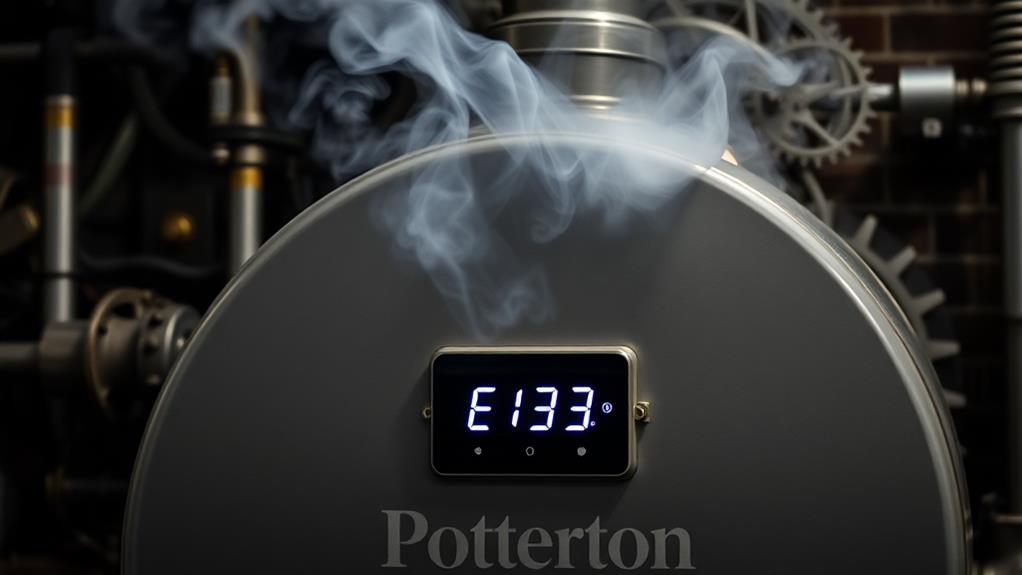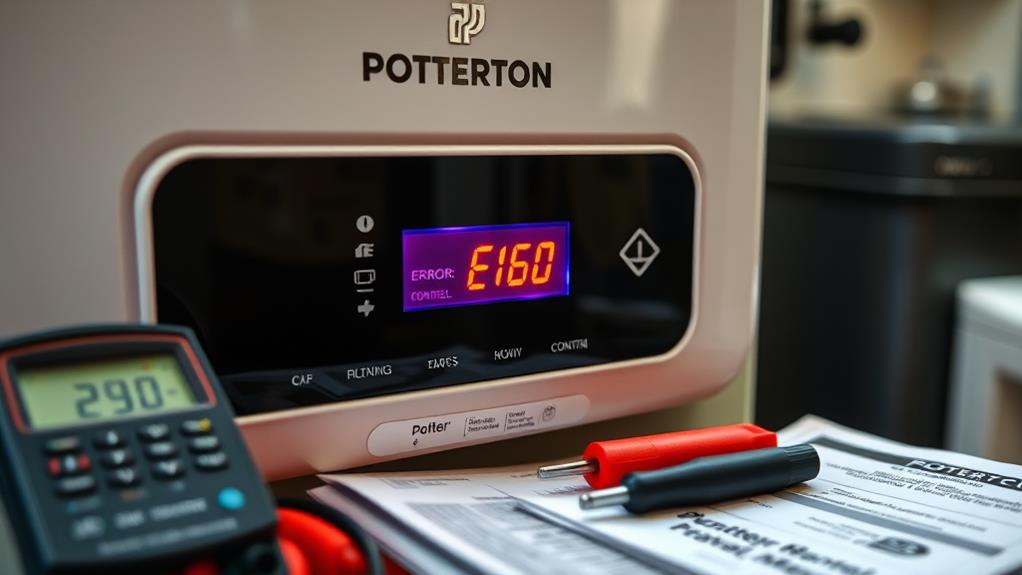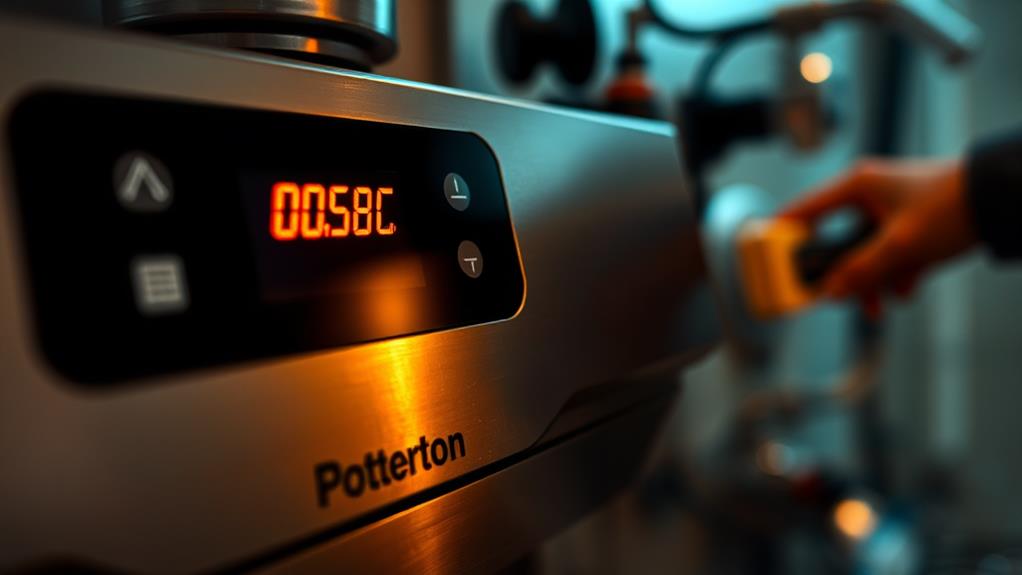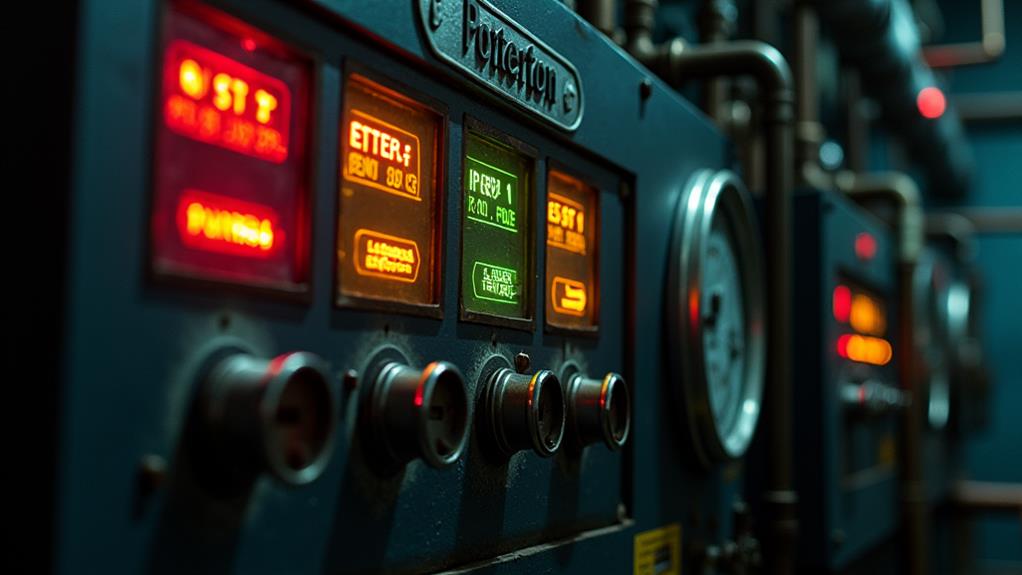You’re likely encountering Potterton boiler error codes such as E133, which signals ignition sequence failures, often due to gas supply or ignition electrode issues. E119 generally denotes low water pressure from leaks or air entrapment. If you see E160, expect fan faults or air pressure switch problems. Rapid temperature rise, triggering codes like E110, suggests heat exchanger blockages or thermostat malfunctions. E168 involves control system communication errors, while E125 highlights insufficient water flow or circulation blockages. Finally, E193 indicates a disconnect between the control board and thermostat. Continue exploring for in-depth troubleshooting techniques and preventive maintenance strategies.
Key insights
- Potterton boiler error codes help diagnose specific faults, such as E133 for ignition failures and E119 for low water pressure.
- Error code E160 indicates fan or air pressure switch issues, often requiring inspection of the fan assembly.
- E110 suggests overheating problems due to heat exchanger blockages or faulty thermostats.
- E168 and E193 indicate communication errors, often resolved by checking wiring and control board connections.
- Regular maintenance, including system flushing and pressure checks, helps prevent these errors.
Understanding Error Code E133

Error Code E133 on a Potterton boiler typically indicates a failure in the ignition sequence, often related to a gas supply or ignition issue. When this code appears, you need to engage in error code troubleshooting to identify the root cause. First, verify the gas supply by confirming the gas valve is open and there’s no disruption in the gas line. Inspect the ignition electrode and cable for any signs of wear or corrosion, as these components are essential for successful ignition.
For a thorough check, consider engaging a commercial boiler service as they have the necessary expertise and can also help in maintaining the boiler’s operational efficiency. Regular checks not only help in identifying minor issues early but also enhance energy efficiency, leading to lower operational costs.
For effective boiler maintenance tips, regularly check the condensate pipe for blockages, especially during cold weather, as freezing can impede proper function. Confirm that the pressure in the system remains within the recommended range, typically between 1-1.5 bar. Use a pressure gauge to verify this parameter, adjusting as necessary.
It’s vital to keep the boiler’s service history up-to-date. Schedule routine maintenance checks to preemptively address any potential faults. Such proactive measures can greatly reduce the frequency of encountering error codes like E133. If the error persists despite these checks, consider consulting a certified technician to conduct a thorough examination and repair.
Troubleshooting Error Code E119
When troubleshooting the E119 error code on your Potterton boiler, you’ll need to first identify the root causes, often linked to low water pressure. Regular plant room maintenance can help prevent such issues, as routine inspections and servicing are vital for identifying potential leaks and monitoring system levels. Address the pressure issues by checking the pressure gauge and repressurizing the system if necessary, ensuring it falls within the recommended 1.0 to 1.5 bar range. It’s important to adhere to safety protocols when dealing with boiler systems to prevent gas leaks and potential explosions. To prevent future occurrences, regularly monitor system pressure and inspect for potential leaks in the heating circuit.
Causes of E119 Error
Encountering the E119 error code on your Potterton boiler signals a potential issue with low water pressure within the central heating system. This error often stems from inadequate system pressure management, which can manifest due to several underlying causes. The most prevalent is a leak in the boiler or associated pipework that compromises pressure integrity. Inspect connections and joints meticulously, as even minor seepages can precipitate pressure drops.
Another frequent cause is air entrapment within the radiators, leading to suboptimal water circulation and pressure inconsistencies. Regular venting of radiators is an essential aspect of boiler maintenance tips, guaranteeing air pockets do not disrupt system equilibrium. Confirm you’re familiar with your system’s pressure gauge, as fluctuations might indicate potential issues before they escalate.
Furthermore, the pressure relief valve or expansion vessel could malfunction, resulting in uncontrolled pressure release or inadequate pressure retention. Periodic examination and testing of these components are indispensable to prevent recurring E119 errors. Verify that the filling loop is correctly closed post-refill, as an open loop can inadvertently lead to pressure fluctuations. A proactive approach to system checks and adherence to boiler maintenance tips will mitigate the likelihood of encountering the E119 error code.
Resolving Pressure Issues
Addressing the E119 error code requires a methodical approach to resolving pressure issues within your Potterton boiler system. First, you need to examine the boiler pressure using the pressure gauge, typically located on the front panel. Ideal pressure levels should read between 1.0 and 1.5 bar. If the gauge indicates a pressure below 1.0 bar, it suggests insufficient pressure, triggering the E119 error.
To rectify this, locate the filling loop, a flexible hose often found below the boiler. Make sure both valves on the filling loop are closed before proceeding. Slowly open these valves to allow water to enter the system, carefully monitoring the pressure gauge. Once the gauge reads the recommended range, close both valves promptly to avoid over-pressurization.
If your pressure gauge consistently displays incorrect readings, it may indicate a malfunction. In such cases, recalibration or replacement of the gauge might be necessary. Additionally, inspect for any leaks within the system that may contribute to pressure loss. Repairing leaks or replacing faulty components will stabilize boiler pressure, effectively clearing the E119 error. By following these steps, you’ll guarantee your Potterton boiler operates efficiently without further disruptions.
Preventing Recurrence Strategies
To effectively prevent the recurrence of the E119 error code in your Potterton boiler, it is essential to implement a systematic approach to regular maintenance and monitoring. Begin by scheduling periodic inspections to guarantee all components function at their best, focusing on pressure relief valves, expansion vessels, and pressure sensors. Regular maintenance involves flushing the system to eliminate sludge and debris, which can impair pressure regulation. Additionally, check for leaks in the pipework and rectify any found immediately.
Furthermore, consider implementing system upgrades to enhance boiler efficiency. Upgrading to a smart thermostat can provide real-time monitoring of system pressure, alerting you to potential issues before they escalate. Incorporate pressure management devices to maintain ideal pressure levels automatically. It’s also wise to replace obsolete components with high-efficiency alternatives to prevent future malfunctions.
Incorporate a robust monitoring system that includes pressure gauges and digital controls. This setup allows for precise adjustments and immediate diagnostics, reducing the likelihood of encountering the E119 error. By integrating these strategies, you can guarantee your Potterton boiler remains in peak condition, minimizing downtime and extending the unit’s lifespan. Remember, diligent attention to regular maintenance and system upgrades is your best defense against recurring issues.
Resolving Error Code E160

When your Potterton boiler displays the E160 error code, it signifies a fan fault or an issue with the air pressure switch, critical components in the appliance’s operation. To address this, you’ll need to conduct a meticulous inspection of the fan assembly and the air pressure switch. By confirming the fan is free of obstructions and rotates smoothly, you’re preventing potential hazards like gas leaks and carbon monoxide poisoning, which are important safety standards to meet.
Next, examine the air pressure switch, a pivotal device that monitors and maintains the correct air pressure for safe combustion. Verify the integrity of its connections and hoses for any signs of wear or disconnection. Accurate readings from this switch are essential for boiler maintenance and error prevention, as they guarantee that the system operates within safe parameters.
Additionally, check the wiring harness for any loose or corroded connections, as these can cause intermittent faults leading to the E160 error. Regular servicing, as part of your routine boiler maintenance, can help prevent such issues. By adhering to these steps, you can efficiently resolve the E160 error and maintain peak boiler functionality, guaranteeing your system runs safely and reliably.
Fixing Error Code E110
Having tackled the E160 error, it’s time to focus on the E110 error code, which indicates an issue with the boiler’s water temperature. This code suggests that the water temperature is rising too quickly, triggering the overheat thermostat. To address this, verify that your boiler’s heat exchanger isn’t blocked by limescale or debris, which can impede water flow. Regular maintenance, as recommended in our commercial boiler guide, can help prevent such blockages. Conduct a thorough inspection of the heat exchanger and clean it if necessary, using appropriate descaling solutions.
Begin by turning off the boiler and allowing it to cool for safety. Remove the casing and locate the heat exchanger, typically found near the boiler’s top. Inspect for blockages, and if detected, carefully perform descaling. Consistent boiler maintenance is vital for error prevention, so consider scheduling regular checks with a qualified technician who can also guarantee compliance with safety regulations.
Additionally, inspect the thermostat and temperature sensors. Malfunctioning components should be replaced promptly. Verify that the boiler’s pump is operational, as a faulty pump can cause inadequate water circulation, leading to overheating. By addressing these potential issues, you’ll guarantee peak boiler performance and reduce the likelihood of encountering the E110 error in the future. Prioritize regular maintenance to minimize unexpected disruptions.
Addressing Error Code E168

Dealing with the E168 error code involves understanding its association with communication errors in Potterton boilers. This error code typically indicates a failure in the boiler’s electronic control system, often linked to a discrepancy between the main circuit board and the sensor signals. It is vital to remember that safety is paramount when dealing with boiler issues, making it necessary to follow guidelines similar to those found in the Commercial Gas Safety Certificate, guaranteeing the safety and compliance of your gas appliances. To address this, you should initiate a systematic diagnostic approach, starting with a reset of the boiler’s system. This can sometimes clear transient faults.
For more persistent issues, inspect the wiring harness for any signs of damage or loose connections, as these can disrupt communication. Utilizing a multimeter, verify the continuity and voltage levels in the control circuit. Ascertain that all connectors are firmly seated and free of corrosion.
Implementing boiler maintenance tips is important. Regularly clean and inspect the boiler’s components, focusing on the PCB and sensor interfaces. Dust and debris can cause erroneous readings, leading to the E168 error code. It is significant to remember that regular inspections are necessary for maintaining ongoing safety, as emphasized in the importance of regular monitoring in commercial gas safety.
As part of error code solutions, consider updating the boiler’s firmware if updates are available, confirming compatibility with the latest diagnostic tools. If these measures prove insufficient, consulting a professional engineer with experience in Potterton systems is recommended for advanced troubleshooting.
Common Causes for Error Code E125
When addressing Error Code E125 on your Potterton boiler, focus on the critical factors of insufficient water flow and pump circulation issues. This error could be a sign indicating the need for a commercial power flush to clear any obstructions that are affecting the efficiency of your heating system. Verify that the system’s pump is operating efficiently, as any obstruction or malfunction can disrupt proper water movement. Additionally, check for airlocks within the system, which can impede water circulation and trigger this error code.
Insufficient Water Flow
Several factors can contribute to insufficient water flow in a Potterton boiler, often triggering error code E125. When water flow is inadequate, boiler efficiency can be greatly compromised. One primary concern is the presence of blockages within the system. Debris or sludge accumulation in the heat exchanger or piping can restrict water movement, reducing the overall thermal efficiency. To mitigate this, regularly flush the system to maintain ideal conditions.
Another potential issue is air entrainment within the system. Air pockets can impede water flow, causing inconsistent heating and pressure fluctuations. Bleeding the radiators and confirming a properly sealed system can rectify this. Additionally, check the water pressure. If the pressure falls below the recommended level, water flow can decrease, affecting the boiler’s performance. Verify the pressure gauge and adjust using the filling loop as necessary.
Inspect the thermostat settings, as incorrect configurations can lead to inefficient water circulation. Confirm the thermostat is calibrated to maintain a steady temperature. Finally, examine the condition of the inlet filters. Clogged filters can impede water flow, so regular maintenance and cleaning are essential to guarantee unhindered operation and prevent error code E125.
Pump Circulation Issues
Addressing pump circulation issues is essential to resolving error code E125 in Potterton boilers. The efficiency of your boiler’s performance heavily relies on the smooth operation of the pump, which guarantees proper water circulation throughout the system. If you’re experiencing E125 errors, it’s important to focus on the pump’s functionality. Here are three common causes you should consider:
- Pump Blockage: Debris or scale buildup can obstruct the pump, impeding water flow. Regular pump maintenance, including cleaning and inspection, is critical to prevent blockages and maintain peak performance.
- Pump Failure: Over time, mechanical components within the pump can wear out, leading to reduced efficiency or complete failure. If you’ve exhausted maintenance options and the pump still malfunctions, pump replacement might be necessary to restore proper circulation.
- Electrical Faults: Faulty wiring or connections can disrupt the pump’s operation, causing intermittent or insufficient water movement. Inspect electrical components regularly to verify they’re secure and functioning correctly.
Airlock in System
An airlock in the system can, by obstructing water flow, lead to error code E125 in Potterton boilers. When air is trapped within the central heating system, it creates a blockage that impedes efficient circulation. Airlock symptoms include unusual gurgling noises, intermittent heating, and radiators that remain cold despite the boiler being operational. These signs suggest trapped air is disrupting consistent water flow, triggering the boiler’s safety mechanisms and causing it to display error code E125.
To resolve this, begin by identifying the location of the airlock. Common areas include the highest points in the system, such as radiators or the boiler’s pump. As an airlock solution, you should employ manual bleeding of radiators. Use a radiator key to gently release trapped air until water flows steadily. Confirm all affected radiators are addressed to restore uniform heating. Additionally, verify the system’s pressure, typically between 1.0 and 1.5 bar; adjust if necessary using the filling loop.
If airlock issues persist, consider examining the boiler’s pump settings. Verify the pump speed is appropriate for your system’s requirements, as incorrect settings can exacerbate airlock formation.
Tips for Error Code E193

When your Potterton boiler displays Error Code E193, it indicates a communication issue between the boiler’s control board and the thermostat. This error can disrupt your heating system’s functionality, but with precise boiler maintenance and error code solutions, you can effectively address it. First, you should verify that the control board is receiving adequate power and that all connections are secure. Here are some essential steps to take into account:
- Inspect Wiring Connections: Verify that the wiring between the thermostat and the control board is intact. Loose or damaged wires can cause signal interruptions, so tighten any loose connections and replace frayed cables.
- Check Thermostat Settings: Confirm that the thermostat is set correctly and configured to communicate with your boiler. Misconfigured settings may lead to a lack of synchronization, preventing proper operation.
- Reset the Boiler System: Sometimes, a simple reset can resolve the error. Turn off the boiler, wait a few minutes, and then turn it back on. This action can re-establish communication between the components.
Frequently Asked Questions
How Often Should I Service My Potterton Boiler to Prevent Error Codes?
You should service your boiler annually to prevent error codes. This service frequency guarantees peak performance and identifies potential issues early. During maintenance, a technician will inspect heat exchangers, check combustion settings, and clean filters, assuring efficient operation. Regular servicing reduces the risk of breakdowns and extends the boiler’s lifespan. Don’t neglect routine maintenance—it’s vital for safety, energy efficiency, and avoiding costly repairs. Always follow manufacturer guidelines for precise maintenance tips.
Can Error Codes Indicate a Need for a Boiler Replacement?
When it rains, it pours. Error codes can indeed signal a need for boiler replacement. Evaluate error severity carefully; frequent or critical codes may indicate your boiler’s nearing the end of its lifespan. Consider a technician’s assessment for precise diagnostics. If issues persist despite regular servicing, it might be time to explore replacement options. Addressing this promptly can prevent further complications and guarantee your heating system’s reliability.
Are Potterton Boiler Error Codes Covered Under Warranty?
When dealing with error code interpretation, you must first check your warranty coverage details. Most warranties cover manufacturing defects, but they might not include service calls for minor issues or user errors. If the error code indicates a major internal fault, you’re likely covered. However, always verify the specifics of your warranty. Contact your provider with the error code specifics to confirm whether your situation meets the warranty’s terms.
What Tools Are Needed for Basic Potterton Boiler Troubleshooting?
To effectively troubleshoot your boiler, you’ll need vital boiler tools. Start with a multimeter for electrical diagnostics and a manometer for pressure checks. A combustion analyzer guarantees ideal gas mix. Use a spanner set for tightening connections, and a flue gas analyzer is essential for detecting leaks. Familiarize yourself with troubleshooting techniques like checking thermistors and inspecting pressure relief valves. Always follow safety protocols to guarantee precise and accurate diagnostics.
How Can I Reset My Potterton Boiler After Fixing an Error?
Oh, the joys of modern technology! You’ve fixed the error, and now, you just need to reset the boiler. Here’s what you do: locate the reset button—typically, it’s on the control panel. Press and hold it for about five seconds. If only all troubleshooting techniques were this straightforward, right? Confirm the boiler’s power cycle is complete before releasing. Voilà, your boiler reset methods should restore functionality, assuming no further underlying issues exist.
Summary
In the whimsical world of boiler diagnostics, you’re not just a homeowner—you’re a code-cracking sleuth! As you tango with E133’s gas escapades, wrestle E119’s pressure tantrums, or soothe E160’s fan drama, remember: your boiler’s just a misunderstood mechanical diva. E110 might try to steam things up, and E168 will test your patience, but armed with precision and a toolbox of sarcasm, you’ll reign victorious over these temperamental titans. Happy troubleshooting, maestro!

